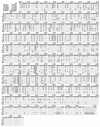Association of a thr-371 substitution in a conserved amino acid motif of penicillin-binding protein 1A with penicillin resistance of Streptococcus pneumoniae
- PMID: 9736547
- PMCID: PMC105808
- DOI: 10.1128/AAC.42.9.2267
Association of a thr-371 substitution in a conserved amino acid motif of penicillin-binding protein 1A with penicillin resistance of Streptococcus pneumoniae
Abstract
We determined the nucleotide sequence between 1,903 and 3,097 bp of pbp1a, which encodes the transpeptidase domain of PBP 1A, from clinical isolates of penicillin-resistant Streptococcus pneumoniae (PRSP) serotypes 19 (n = 8), 6 (n = 9), 23 (n = 6), and 14 (n = 2) and two penicillin-susceptible S. pneumoniae (PSSP) isolates. These serotyped PRSP strains were isolated predominantly in Japan from 1993 through 1997. The 25 resistant strains were classified into five groups on the basis of the extent of sequence differences. Strains in groups I (n = 5; serotype 6), II (n = 3; serotype 19), and III (n = 12; different serotypes) had sequences highly homologous to the sequence of pbp1a of PRSP strains from South Africa, Spain, and the United States. The group IV strain (n = 1; serotype 14) had unique deletions from or insertions in the sequences. The sequences of group V strains (n = 4; serotypes 6 and 23) had relatively few differences from the sequences of the PSSP strains. For strains (n = 18) for which the threonine at codon 371 (Thr-371) in a conserved STMK motif of PBP 1A was substituted with an alanine or a serine (in addition to having altered pbp2x and pbp2b genes), penicillin MICs were >/= 1.0 microgram/ml. The PBPs 1A of these strains showed decreased affinities for [3H]benzylpenicillin and slightly faster mobilities on sodium dodecyl sulfate-polyacrylamide gels. In contrast, for strains (n = 4) without a substitution at Thr-371 in PBP 1A but with mutations in both pbp2x and pbp2b, penicillin MICs were 0.125 to 0.25 microgram/ml, and the affinities of their PBPs 1A were similar to that of PSSP PBPs 1A. Furthermore, for the Thr-371-substituted strains (n = 3) with altered pbp2x genes but native pbp2b genes, penicillin MICs were 0.125 to 0.25 microgram/ml. These results suggest that amino acid substitution of Thr-371 contributes to the development of penicillin resistance in PRSP strains with altered pbp2x and pbp2b genes.
Figures





References
-
- Barcus V A, Ghanekar K, Yeo M, Coffey T J, Dowson C G. Genetics of high level penicillin resistance in clinical isolates of Streptococcus pneumoniae. FEMS Microbiol Lett. 1995;126:299–304. - PubMed
-
- Coffey T J, Berron S, Daniels M, Garcia-Leoni M E, Cercenado E, Bouza E, Fenoll A, Spratt B G. Multiply antibiotic-resistant Streptococcus pneumoniae recovered from Spanish hospitals (1988–1994): novel major clones of serotypes 14, 19F, and 15F. Microbiology. 1996;142:2747–2757. - PubMed
-
- Coffey T J, Dowson C G, Daniels M, Zhou J, Martin C, Spratt B G, Musser J M. Horizontal transfer of multiple penicillin-binding protein genes and capsular biosynthetic genes, in natural populations of Streptococcus pneumoniae. Mol Microbiol. 1991;5:2255–2260. - PubMed
-
- Dowson C G, Coffey T J, Kell C, Whiley R A. Evolution of penicillin resistance in Streptococcus pneumoniae; the role of Streptococcus mitis in the formation of a low affinity PBP2B in S. pneumoniae. Mol Microbiol. 1993;9:635–643. - PubMed
MeSH terms
Substances
Associated data
- Actions
- Actions
- Actions
- Actions
- Actions
- Actions
- Actions
- Actions
- Actions
- Actions
- Actions
- Actions
LinkOut - more resources
Full Text Sources
Research Materials
Miscellaneous

